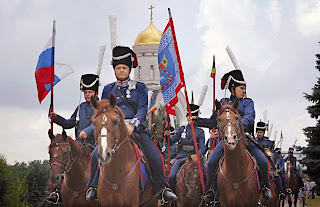
Russia’s Cossacks Increasingly Diverse, Numerous and Important
By Paul Goble
With each passing month, the number and diversity of Russia’s Cossack community become greater, with both aspects increasing faster than Moscow can keep track. Last week, the regional development ministry published its latest count of members of the 11 Cossack voiskas (“armies”), but even before the ink was dry on that document, both the number and diversity of this group, now recognized as a nation by some Russian regions, increased with the return of 2,000 Semireche Cossacks from Kyrgyzstan and Kazakhstan (nazaccent.ru/content/9780-ministr-regionalnogo-razvitiya-vstretitsya-s-atamanami.html).
The Semireche Cossacks, whose “voisko” was established only in 1867 to provide a Russian defense line in what is now southeastern Kazakhstan and northern Kyrgyzstan, are among the least well-known of the Cossack communities. But they now take their place beside and add to the numbers Moscow announced: 126,000 members of the Grand Voisko of the Don, 75,000 of the Central Cossack Voiska, 14,000 of the Volga Voisko, 66,000 of the Yenisey Voisko, 6,000 of the Trans-Baikal Voisko, 4,500 of the Irkutsk voisko, 146,000 of the Kuban Voisko, 25,000 for the Orenburg Voisko, 6,000 for the Siberian Voisko, 30,000 for the Terek Voisko, and 6,000 for the Ussuri Voisko, for a total of 506,000 Cossacks now registered with the Russian state (minregion.ru/press_office/news/3747.html).
Most Cossacks on this list are members of the Triune Cossacks of the Don—Kuban and Terek—about whom most Russians have some knowledge albeit distorted from Michail Sholokhov’s novels and about whom most people outside Russia have a very distorted image thanks to Hollywood. The knowledge of both is inadequate in at least three respects. First, although almost all Cossacks stood at the defense of the borderlands of the Russian Empire in the past and seek to reprise that role now, they were hardly all the same: The Trans-Baikal Cossacks, to give the clearest example, were mostly Buddhists, a fact that does not fit easily into either Russian or Western imagery.
Second, the numbers the Russian government is offering are far too low. Many Cossacks refuse to register with the authorities, and Cossack groups have offered estimates of the total number of Cossacks as two million or more. And third, there is a problem in defining who is a Cossack and who is not. Many Cossacks now view themselves as a nation rather than a social stratum, as the Russian and Soviet governments defined them, and thus stress descent from earlier Cossack generations. But many who identify as Cossacks now are self-declared. They have no such roots but simply identify with what they see as Cossack values. Some Cossack leaders accept these “neo-Cossacks” as welcome members to their ranks, but others do not.
There are currently three all-Russian laws and 21 regional laws governing the Cossacks. Yet, judging by the Russian legislation, as well as the increasing use of Cossacks not only as symbols of Russian state power but as the core of popular militias intended to maintain order in Russia’s regions and cities, the Cossacks are going to play a growing role in Russian life—even if ever more of them celebrate their diversity and distinctiveness from the Russian nation.




